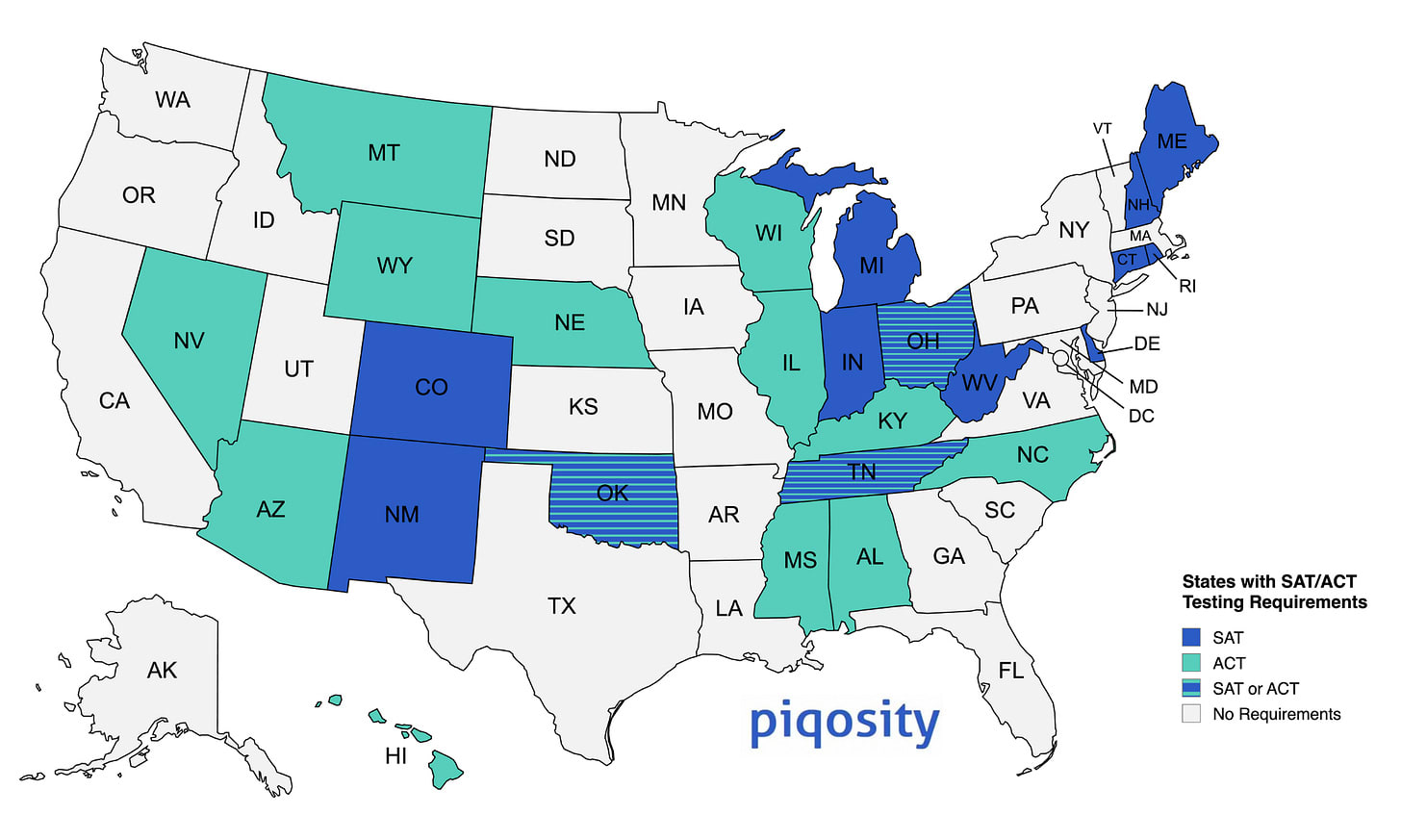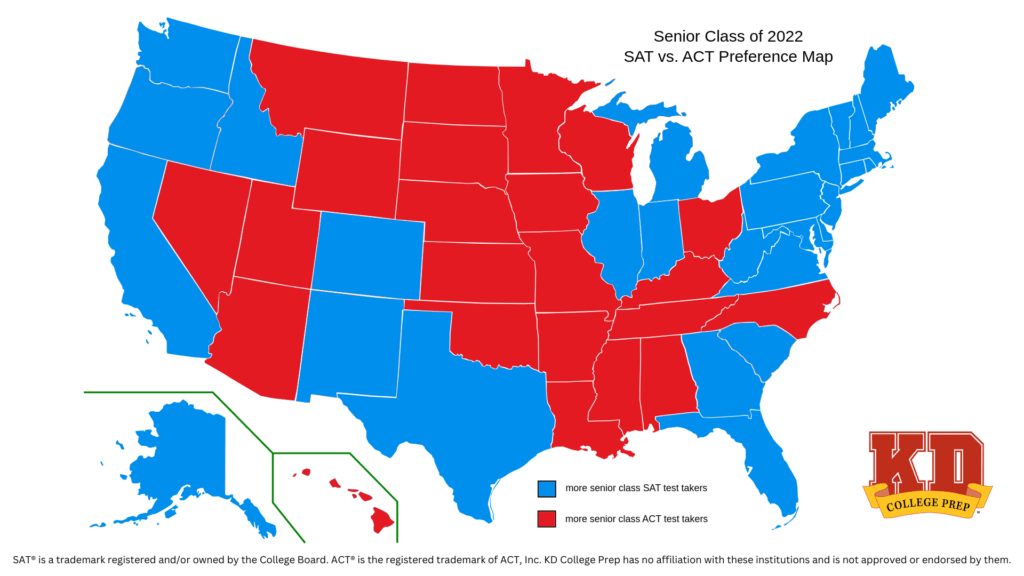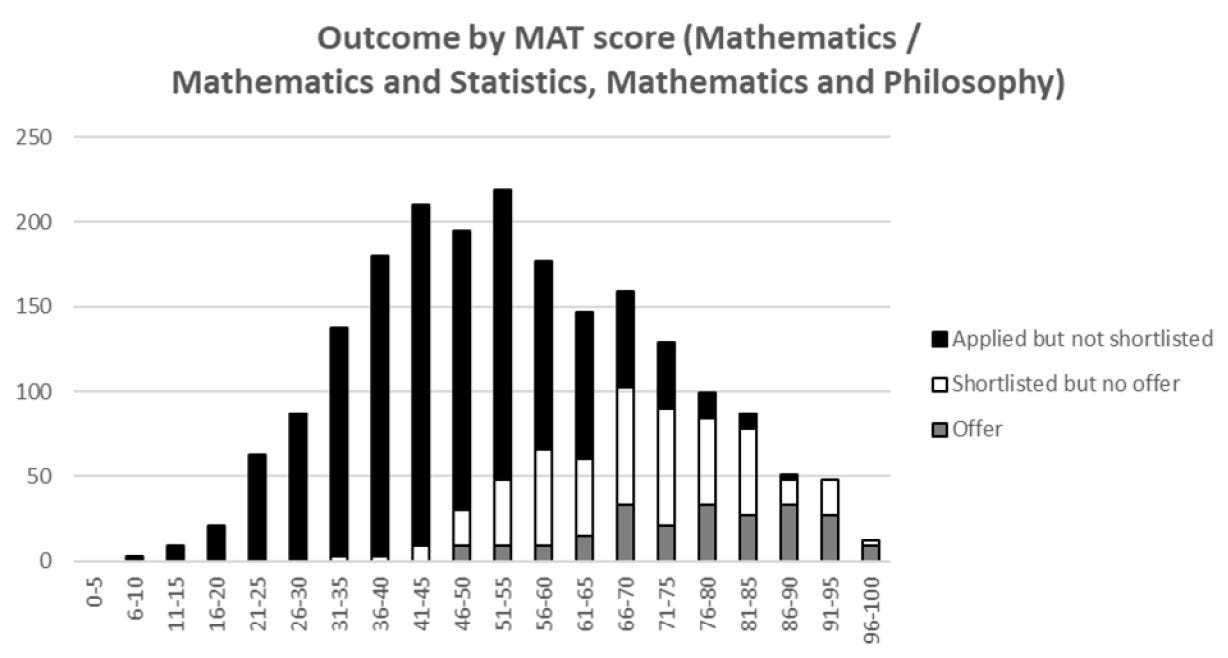Published on April 7, 2025 5:35 PM GMT
Spoiler: “So after removing the international students from the calculations, and using the middle-of-the-range estimates, the conclusion: The top-scoring 19,000 American students each year are competing in top-20 admissions for about 12,000 spots out of 44,000 total. Among the Ivy League + MIT + Stanford, they’re competing for about 6,500 out of 15,800 total spots.”
It’s well known that
- Admission to top universities is very competitive in America and even top SAT scores (1550+ out of 1600) paired with a 4.0 GPA doesn’t guarantee admission to a top school.Even top universities take into account race-based affirmative action, athletic recruitment, “Dean’s Interest List”-type tracking systems for children of donors or notable persons, and legacy preference for children of alumni.
But many people are under the misconception that the resulting “rat race”—the highly competitive and strenuous admissions ordeal—is the inevitable result of the limited class sizes among top schools and the strong talent in the applicant pools, and that it isn’t merely because of the reasons listed in (2). Some even go so far as to suggest that a better system would be to run a lottery for any applicant who meets a minimum “qualification” standard—under the assumption that there would be many such qualified students.
But in reality, the top 20 schools together enroll about 49,000 students. That’s about 1.3% of the 3.8 million students who graduate high school each year in the United States. If you restrict it to the eight Ivy League schools + Stanford + MIT, those ten schools together enroll 17,500 students per year. Below I’ll argue that there isn’t a huge oversupply of talent at all for these spots, even with the limitations of current metrics, and certainly not with metrics that would be available if the SAT was made more difficult in line with historical standards.
| Rank | School | Freshman Class Size | SAT 25th Percentile | SAT 50th Percentile | SAT 75th Percentile | % Foreign |
|---|---|---|---|---|---|---|
| 1 | Princeton | 1,400 | 1,450 | 1,528 | 1,570 | 10 |
| 2 | MIT | 1,100 | 1,510 | 1,535 | 1,580 | 10 |
| 3 | Harvard | 1,700 | 1,460 | 1,528 | 1,580 | 10 |
| 4 | Stanford | 1,700 | 1,420 | 1,535 | 1,570 | 15 |
| 5 | Yale | 1,600 | 1,460 | 1,521 | 1,580 | 10 |
| 6 | Caltech | 250 | 1,530 | 1,545 | 1,580 | 15 |
| 7 | Duke | 1,700 | 1,510 | 1,533 | 1,560 | 15 |
| 8 | Johns Hopkins | 1,300 | 1,480 | 1,548 | 1,570 | 15 |
| 9 | Northwestern | 2,100 | 1,430 | 1,513 | 1,550 | 15 |
| 10 | UPenn | 2,400 | 1,450 | 1,528 | 1,570 | 15 |
| 11 | Cornell | 3,100 | 1,450 | 1,513 | 1,540 | 10 |
| 12 | UChicago | 1,700 | 1,500 | 1,533 | 1,570 | 15 |
| 13 | Brown | 1,700 | 1,440 | 1,528 | 1,570 | 15 |
| 14 | Columbia | 1,500 | 1,470 | 1,527 | 1,570 | 15 |
| 15 | Dartmouth | 1,200 | 1,440 | 1,520 | 1,560 | 15 |
| 16 | UCLA | 6,600 | 1,290 | 1,405 | 1,520 | 10 |
| 17 | UC Berkeley | 13,700 | 1,290 | 1,415 | 1,530 | 10 |
| 18 | Rice | 1,100 | 1,460 | 1,528 | 1,570 | 10 |
| 19 | Notre Dame | 2,100 | 1,420 | 1,490 | 1,560 | 10 |
| 20 | Vanderbilt | 1,400 | 1,460 | 1,530 | 1,560 | 10 |
About the data:
- The 25th- and 75th-percentile ranges are from US News & World Report 2022.Medians are estimated according to this random site called CollegeRaptor and they seem to be 2025 estimates.The percentage of international (i.e. foreign) students is higher for grad schools than for undergraduate programs, so a university might have an overall international-student percentage of 25% or more, but their percentage among the undergraduate class is almost never above 15%. I rounded to the nearest 5 percentage points and usually used the most recent or second-most-recent freshman classes.Note: The number of enrolled students for a given school is smaller than the number of admitted students, because some admitted students will choose to attend other colleges that also accepted them. Indeed, many top students are accepted to multiple top-20 schools, and a college’s “yield”—i.e. the percent of admitted students who choose to enroll—is an important measure for college rankings and is often around 60% even for Ivy League schools like Cornell, Dartmouth, Brown, and Columbia.)
For reference, the SAT is scored from 400 to 1600 with a mean of about 1000 and a standard deviation of about 200, though it varies from year to year and the College Board—the non-profit that produces the exams—is a bit opaque about how they norm the tests. The newer ACT (founded in 1959) has a slightly different format and gives scores from 1 to 36, with a mean of about 21 and a standard deviation of about 5. About 2 million students took the SAT in 2024 and about 1.4 million took the ACT. The variation is mostly regional: some states require one or the other (or a choice of either) to graduate high school.


With regard to how many students achieve high scores:
- The College Board hasn’t published details statistics about SAT scores since 2008 as far as I can tell, but online I see repeated the claim that in 2021, there were 8,323 (0.4%) students who scored above a 1550. I’m not sure if that claim is accurate. Meanwhile, a 1500 is slightly above the boundary for the 99th percentile.The ACT publishes some exact numbers showing that in 2023 and 2024, roughly
- 3,000 (0.22%) of test-takers achieved the maximum score of 369,300 (0.67%) achieved a score of 3511,800 students (0.86%) achieved a 34
So if you suppose that the same proportion of ACT takers who score a 35 or 36 (together 0.895%) would achieve a 1540 on the SAT, then that’s roughly 34,000 students. If there’s an intermediate score threshold of 1550 or 1560 that represents the top 0.5% of students, then about 19,000 students who graduate each year meet that bar.
Both of these numbers are well below the 49,000-strong intake at top-20 schools. The idea that top students are a dime a dozen isn’t correct; the reality is that top schools admit very many students who have relatively low SAT scores. Under the percentile assumptions in the table above, we can calculate upper and lower bounds showing that top-20 schools are enrolling 16,000–28,000 students who score below 1500 and 30,000–42,000 students who score below 1560. If you restrict it to the Ivy League + Stanford + MIT, then using the data above, out of the combined 17,500 students those ten schools enroll, at least half score under a 1540, and probably closer to 60%.
So after removing the international students from the calculations, and using the middle-of-the-range estimates, the conclusion: The top-scoring 19,000 American students each year are competing in top-20 admissions for about 12,000 spots out of 44,000 total. Among the Ivy League + MIT + Stanford, they’re competing for about 6,500 out of 15,800 total spots.
So for whatever combination of reasons—affirmative action, athletic recruitment, legacy/donor preference, personal essays about running over a feral cat—top schools are accepting a lot of relatively unqualified applicants. Top students are left competing for an artificially small number of slots. The qualitative system (which has merits as well as drawbacks) makes outcomes more uncertain and “yield” considerations sometimes cause schools to reject “overqualified” applicants who are unlikely to enroll; together this leads top students to shotgun applications to many colleges without clarity about the process or outcomes.
As an example of a more functional system, Oxford and Cambridge are the top universities in the UK. Each year they together enroll about 7,000 students out of 700,000 students who finish secondary education, so also about 1% (though about 20% of Oxford undergraduates and 25% of Cambridge undergraduates are from outside the UK). Their system has a bunch of features that make it more predictable and less strenuous:
- Students can only apply to either Oxford or Cambridge but not both. As a result, the “yield rate” is 80% for Cambridge and 90% for Oxford. And UK students can only apply to five undergraduate institutions in total, so weaker applicants won’t apply, especially if they recognize that they won’t reach published minimum score requirements for A-Level exams, standardized content exams similar to AP exams in America.Many subjects use entrance exams. For example, if you want to study math at Oxford, you can review every past entrance exam for free online and if you score in the 80s or 90s you’ll probably be admitted (based on publicly available statistics).

Further, the SAT used to be much harder. In 1991, only nine students scored a 1600, whereas people estimate that over 500 students achieve a perfect score today. The SAT scaled scores upward in 1995 and removed the highly g-loaded analogies section in 2005. Senator Chuck Schumer’s 1600 score from 1967 is off the charts today. But there are no signs of the College Board making the test harder, and meanwhile Princeton, UPenn, and Columbia remain test-optional even now, while UC Berkeley and UCLA don’t consider SAT/ACT scores at all.
If we removed the mechanisms and practices in place that lead top schools to admit many low-scoring students, and if applicants were matched to universities using a stable-marriage system similar to the medical-residency matching system, then the chaos and confusion of the admissions process would basically go away without any more complicated intervention required.
Discuss

